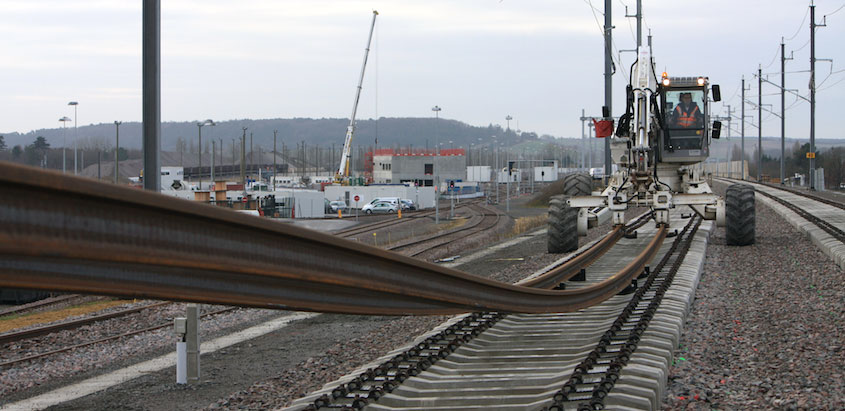D-900: The SEA Tours-Bordeaux high-speed rail line is on track
4 February 2015 - Projects update and handover - France
In 900 days, when the SEA Tours-Bordeaux high-speed rail line begins operating at the end of July 2017, the trip between Paris and Bordeaux will take only two hours and five minutes (while it takes 3 hours today). Track laying and railway equipment installation are under way and the railway offering is being sketched out.
The new South-Europe Atlantic (SEA) high-speed rail line between Tours and Bordeaux is continental Europe's largest worksite and a strategically important factor in regional attractiveness and development. Ultimately, 18 million travellers (a 20% increase from the current number) per year will take advantage of the new line, which will bring people and regions closer together.
An unprecedented logistical challenge
As the infrastructure works draw to a close, the South Europe Atlantic high-speed line has entered the railway works phase, with the first 432 metre continuously welded rails (CWRs) laid along the roadbed of the future SEA HSL near the railway works staging base at Villognon, Charente.
VINCI and its partners have until mid-2016, when testing is to start, to meet an unprecedented logistical challenge and build a 300 km double track line between Tours and Bordeaux.
COSEA and LISEA have set up an efficient partnership.
The design-build construction joint venture, COSEA, led by the VINCI Group's Contracting business, is in charge of laying the tracks and installing the catenaries and the full complement of signalling, telecommunication and power supply equipment. The first train tests are scheduled to get under way in mid-2016. In 2017, COSEA will hand the infrastructure over to the Vinci Concessions-led concession company, LISEA, which will operate the line until 2061.
Another standout feature of the project is the innovation involved in its construction, from the CWR "pusher" wagon (link) to the remotely controlled ballast cars, or "laying machines" that continuously place the sleepers. These techniques enhance the safety of these operations and accelerate their execution.
LISEA gears up for 2017
LISEA has already begun the technical dialogue with RFF (Réseau Ferré de France) about its future management of the infrastructure and with the SNCF about the assignment of "train paths" – national railway time slots available to the operator for train traffic.
The planned opening of the lines to European competition in 2019 will re-shuffle the deck and enable LISEA to acquire new potential customers alongside the SNCF. In addition to shortening the journey time, the project aims to optimise the use of the new infrastructure by creating an offering that meets the expectations of regions, individual users and businesses alike.
Subscribe
18 million travellers per year are expected to use the new line
100% of the 70 million m3 of earthworks and topsoil removal have been completed
233 roads have been reconnected and reopened, out of a total of 287
300 km is the length of the new railway infrastructure

Further information
On the web
LISEA website
Media contacts
Stéphanie Malek
Tel: +33 1 57 98 66 28
media.relations@vinci.com
An environmentally exemplary project
LISEA, COSEA and their dedicated teams have made strong commitments to conserving the archaeological heritage and the biodiversity of the regions through which the line runs.
The SEA is carrying out France's largest-ever preventive archaeology project, which covers 3,000 hectares and involves 50 archaeological digs ahead of construction works.
To minimise the effects of the line on the surrounding regional ecosystems, LISEA and COSEA set up a formal framework within which they worked, from very early stages of the project, with the biodiversity stakeholders (nature conservation groups, farmers, elected officials, relevant government administrations, etc.). Offsets have been implemented, notably with the creation of a 700-hectare offset for the little bustard, a near-threatened migratory grassland bird species, and 720 hectares set aside for the European mink. Additional action to protect biodiversity includes seasonally adjusting site clearance work, re-forestation of as much land as was cleared or more, relocation of certain species and the creation of 800 structures to maintain ecological corridors, ranging from large wildlife overpasses to viaducts and culverts.
Subscribe
50 archaeological digs ahead of construction works
800 structures to maintain ecological corridors
Further information
On the web
Découvrez la Fondation LISEA Biodiversité

